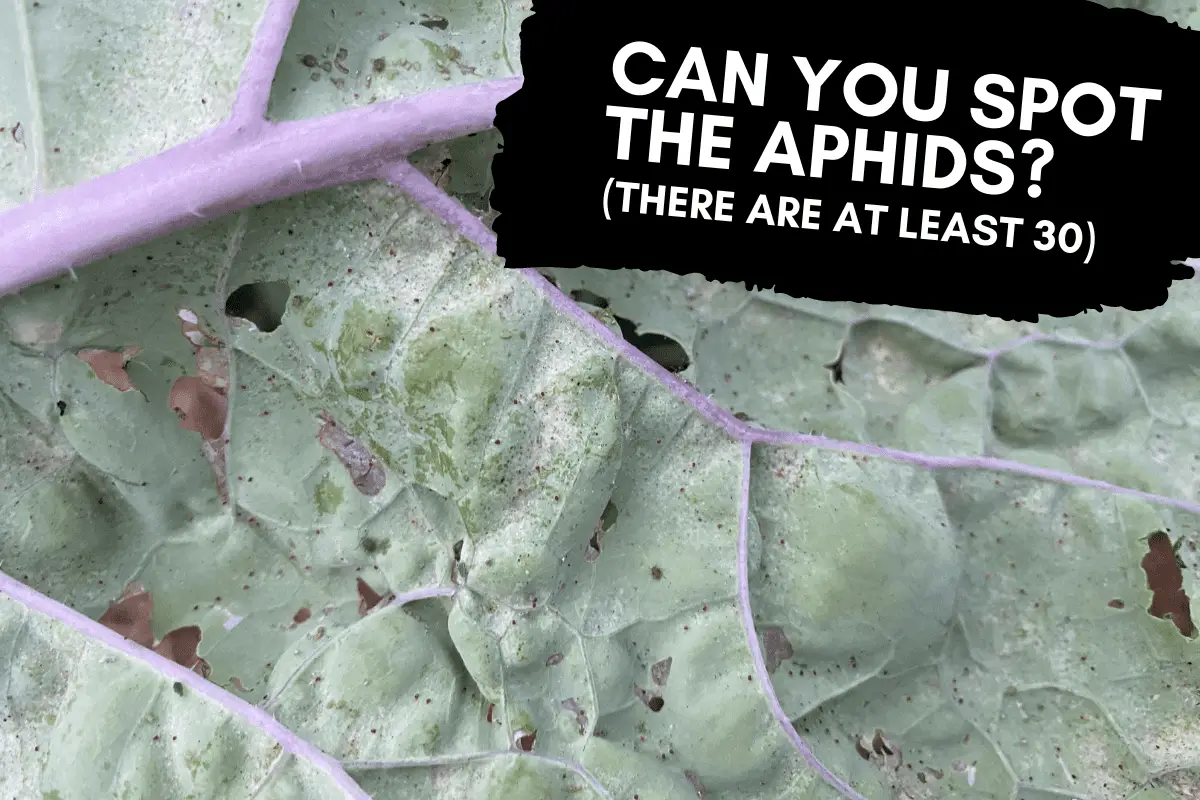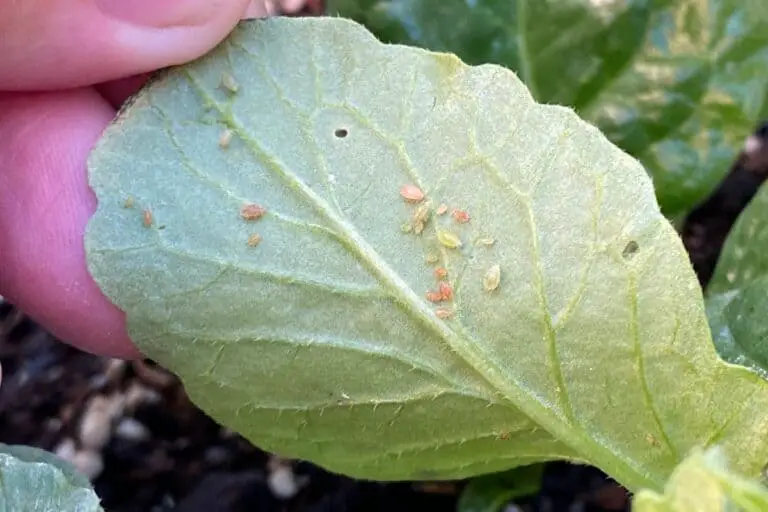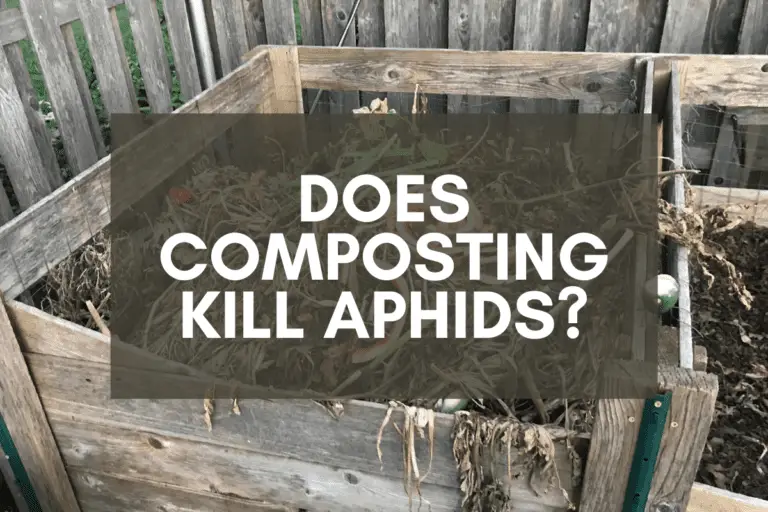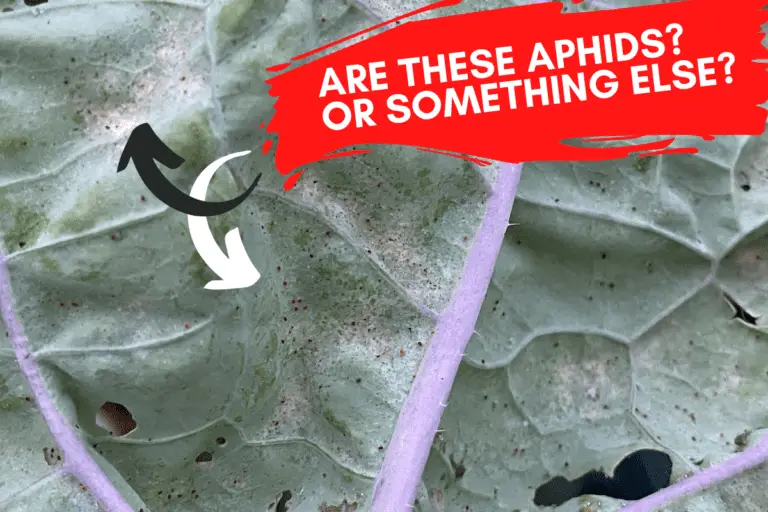Can You See Aphids on Plants? Spotting Early Infestations
When it comes to identifying and stopping garden pests, the first thing you need to do is to understand what you’re looking at. Some bugs are easily seen. Others are microscopic.
So what about aphids? Can you see them on plants?
Unlike many microscopic bugs, aphids are typically 1-3mm long and can be seen on plants with the naked eye. They come in all kinds of colors–from black, brown, gray, and green to pink, purple, red, and yellow–and they typically hide on the undersides of leaves or cluster around buds and flowers.
It’s easy to mistake beneficial insects for harmful bugs–and even easier to overlook small garden pests altogether until they’ve taken over your plant–so in this article, I want to provide a few tips for the early identification of aphids as well as some solutions for getting rid of aphid infestations.
Simply put, if you know what early aphid infestations look like, you can stop them quickly before the aphids reproduce and spread around your garden (and beyond).
What Do Aphids Look Like?
Let’s begin with a quick overview of aphid anatomy so that you’ll know what you’re looking at when you see these bugs in your garden or view images online, then we’ll look at the telltale signs that you’ve got an aphid infestation on your hands.
Some aphids might look a little bit like arachnids when you first glance at them, but aphids only have 6 legs, not 8.
They also have several other defining characteristics:
First of all, they’re incredibly colorful. As I noted above, many aphids are black and green. Others are red, brown, and yellow. Still others appear as various shades of pink, purple, and white. As you can see if you click on these links, I’ve written overview articles about quite a few different-colored species.
Second, aphids can be identified by several telltale features found on their backends. The cauda is a pointy, tail-like protrusion that aphids use in the secretion of honeydew, a sugary byproduct they produce when feeding on plants. The cornices flank the cauda, and they’re used for defensive purposes.
Third, some aphids have wings; others don’t. Depending on the time of year and food availability or lack thereof, female aphids can produce winged aphids that allow the species to migrate from one food source to another.
Understanding aphid anatomy is important, but when it comes to spotting them in your garden, what’s much more important is your ability to recognize the early signs of infestation.
Let’s take a look at those signs below.
How Do You Know If You Have Aphids?
If you catch an aphid infestation early on, you’ll have an easy time getting rid of them. But if you overlook them for a few weeks, you’ll make it possible for them to reproduce exponentially, and you might give them enough time to begin the sexual reproduction process (which typically gets underway in summer and early fall), which means you’ll have eggs deposited in your garden and more aphids to deal with next season.
For this reason, I’d like to share the insights I’ve gathered from years of gardening so that you can recognize an aphid infestation the moment you see one.
Here’s what you’ll want to watch out for:
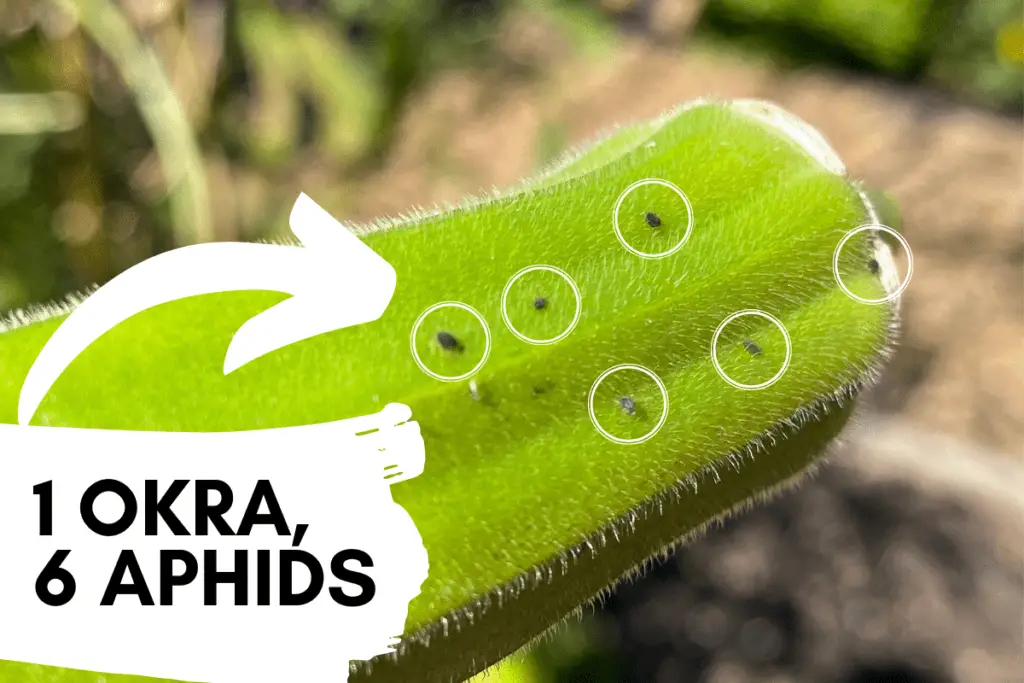
Dots and Specks
Aphids don’t just appear in large clusters overnight. Unlike spider mites, which can sneak into your garden unnoticed and proliferate quickly, aphids will often show up in small numbers. These are typically flying aphids that migrated to your garden from a nearby property or aphids that emerged from overwintered eggs once things warmed up a bit.
Take another look at the photo above. I took that this summer when I first noticed aphids.
Here’s what I want to point out: Even with the image enlarged by more than 200% or so, the aphids still don’t appear to be anything more than black dots or specks.
This is what you’ll want to be on the lookout for when you’re gardening. Aphids are only 1-3 mm long, so you’ll need to pay attention to any dots or specks you see on your plants.
Of course, black aphids on a green okra are easy to spot, so here’s another example.

This is a magnified image of some Red Russian kale that I picked from my garden recently. Unlike the okra, which had a few black aphids on it, this kale has green aphids all over it. And guess what? They’re pretty well camouflaged.
Look closely. How many aphids do you see?
When I look at this kale, I see at least 30 aphids, and what I want you to recognize is how easy it is to miss aphids. If you don’t know what to look for, you likely won’t see them.
Here’s a blown-up image that shows where several aphids were located.

Two aphids are a little darker and thus easier to recognize. But the others are a lighter shade of green–likely because they’re nymphs–so they’re easy to miss.
(I could have drawn more arrows to additional aphids, but didn’t want to clutter up the image!)
Now let’s take a look at a blown-up area of the image at the top of this article. I’ve circled the aphids to make them easier to see.
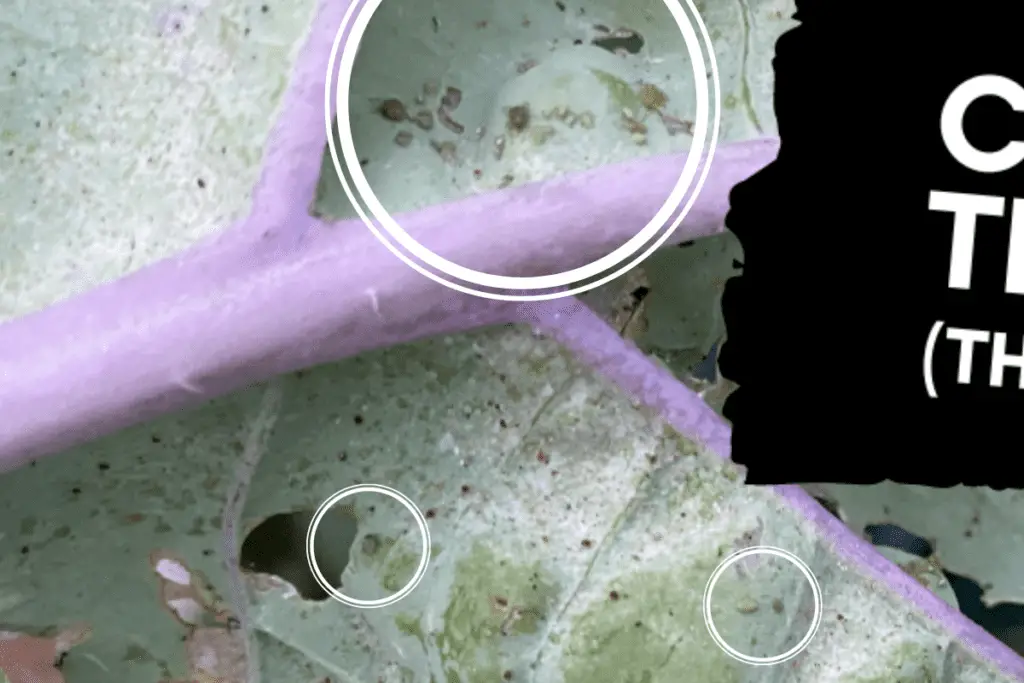
If you take a very close look, you’ll be able to make out the bodies of roughly 15 or so aphids in this one little corner of the leaf. The cluster at top is likely the result of 1-2 female aphids giving live birth to aphid nymphs over the span of 2-3 days.
If left unattended, that small cluster of aphids would have grown into a much larger cluster within a week or two.
Now here’s a quick quiz: Do you see the other aphid cluster in this photo, the one that I haven’t circled? Take another look and see if you can find it.
Have you had a chance to do so?
If you haven’t yet found it, here’s where it is: Look at the circle in the bottom right, then look directly to the right of that circle. Notice that little piece of leaf right next to the purple stem that looks like half an oval? Do you see those little greenish spots perched there? Those are aphids, and it looks like there’s 3 or 4 of them, likely 1 adult aphid and several of her nymphs.
Long story short, aphids are sometimes easy to spot, but at other times, you’ve got to know what you’re looking for or else you’ll overlook them.
Now that we’ve done a deep dive into what aphids typically look like to the naked eyes, let’s look at a few more telltale signs that aphids have arrived in your garden.
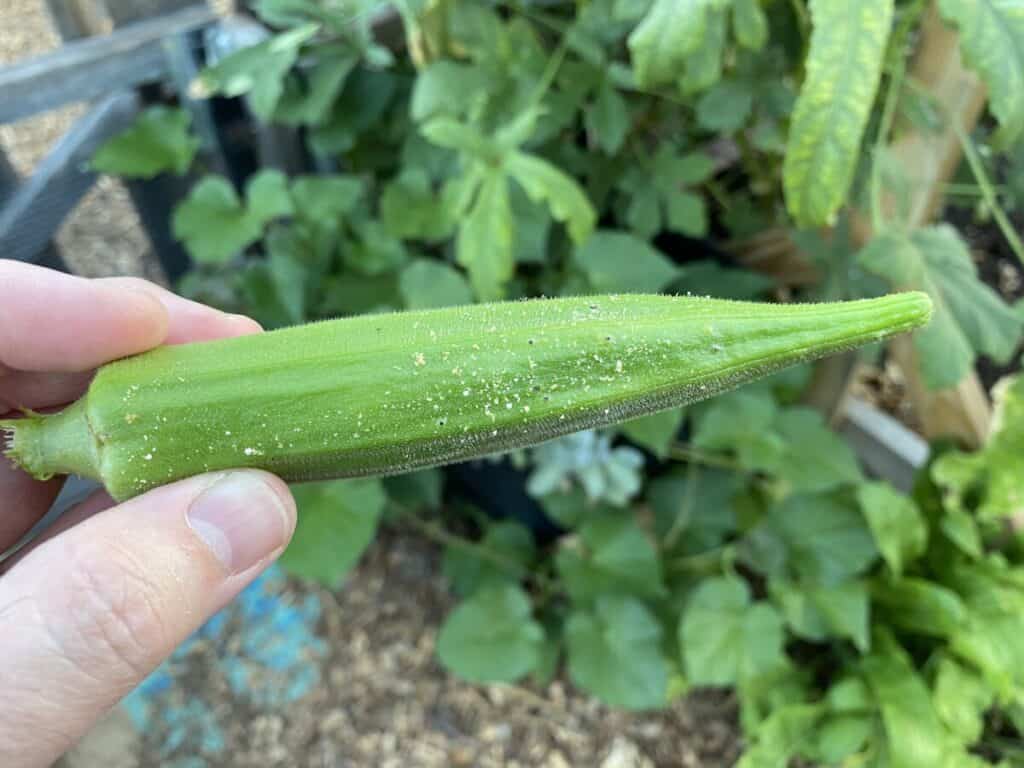
White Flecks and Speckled Clusters
If you see plant foliage that looks like a grouping of light and dark flecks, you’re likely looking at aphids, but what you’re actually seeing are aphids interspersed with their discarded exoskeletons.
As aphids grow from nymphs into adults, they’ll molt and leave their old skins behind. The more aphids on a plant, the more flecks you’ll see, as in the photo below.
Now compare the photo above to this photo:
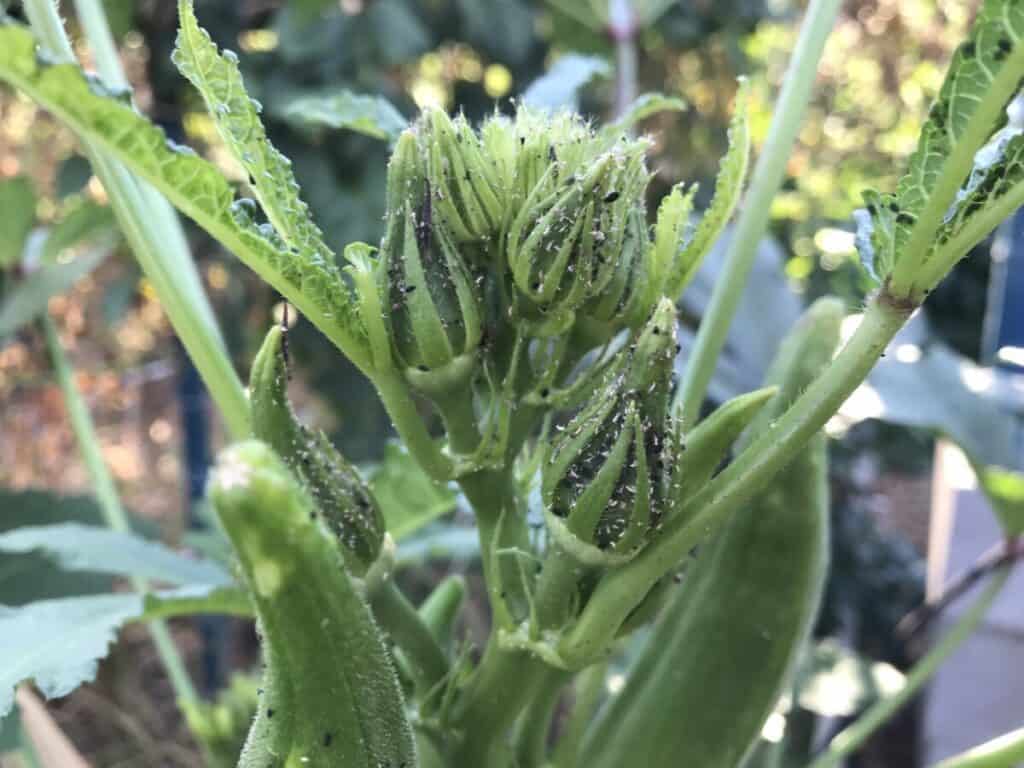
Notice the differences? Unlike in the photo above, there could be 100+ aphids around these okra buds, which is why the flecks are easy to spot.
If the infestation has grown to this point, it’s best to attack the problem quickly so that the aphids don’t begin producing winged versions of themselves and traveling to other plants in your garden.
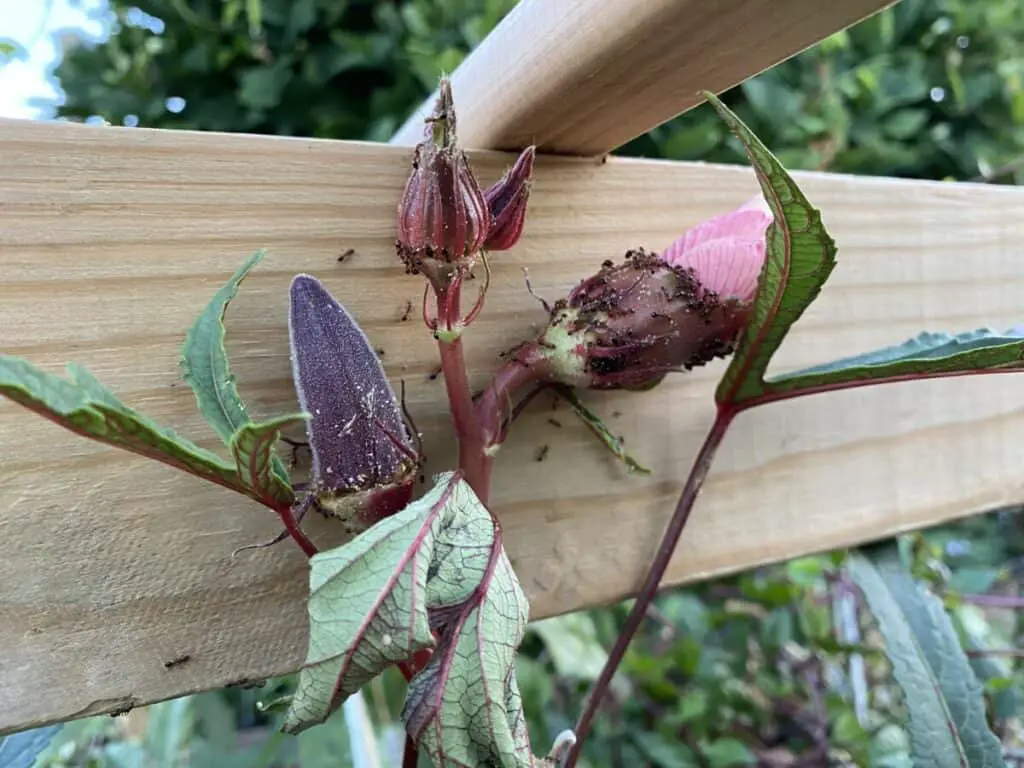
Ants
Aphids will often be accompanied by ants since the latter are especially interested in the honeydew produced by the aphids.
In fact, ants are so interested in the honeydew that they’ll do anything to protect the aphids, including kill off any beneficial insects that would otherwise eat the aphids, such as ladybugs, lacewing larvae, and parasitic wasps.
The more aphids you’ve got, the more honeydew they’ll produce, which will likely draw more ants to your plants.
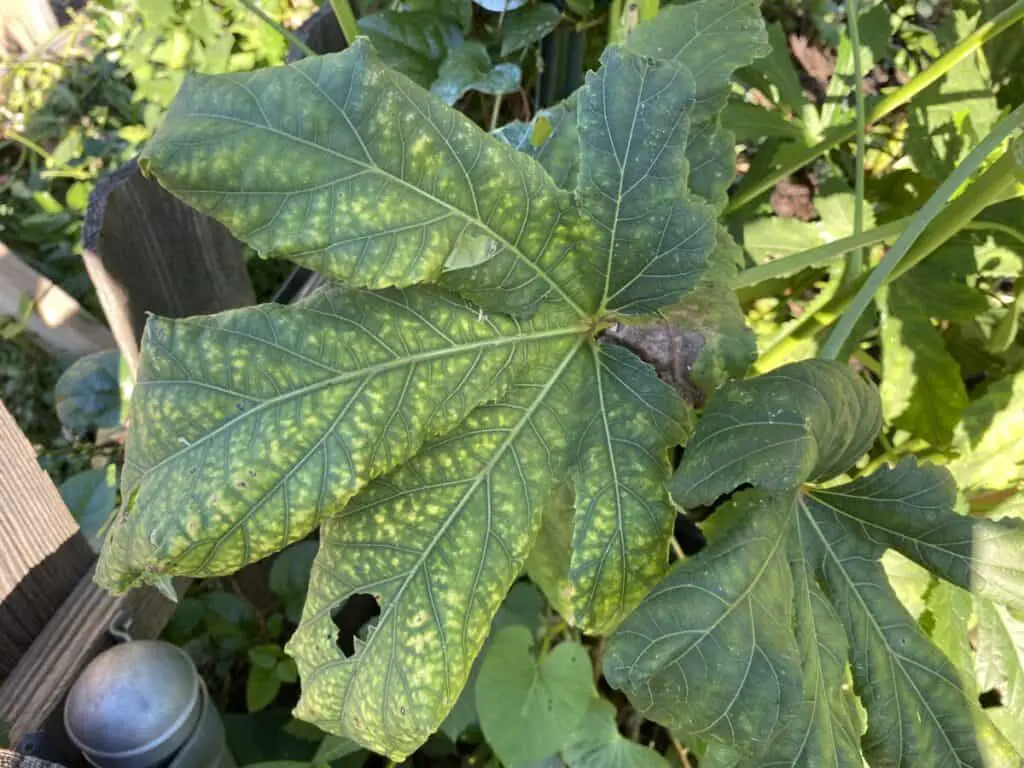
Yellowing or Black Foliage
When aphids find a desired food source, they puncture the plant’s epidermal layers with their piercing mouthparts and begin siphoning off its micronutrients (often referred to as sap). What happens is often a slow yellowing as the plant gets drained of its micronutrients.
You might also see some black sooty-looking material on your plant’s foliage. If that’s the case, what’s happened is that the honeydew secreted by the aphids has encouraged the growth of sooty mold.
If you notice this happening, it’s best to deal with the aphid problem quickly before these issues spread to other nearby plants.
Now that you know what some of the telltale signs are for early aphid infestations, let’s take a quick look at several steps you can take to tackle your aphid problem.
What to Do Once You’ve Seen Aphids: 3 Easy Steps
If you’ve noticed aphids in your garden, I’d recommend doing the following the first chance you get:
1. Spray Them with Water
Water is not a guaranteed solution to your aphid problem. In fact, as I’ve noted in my article on getting rid of white aphids, water has varying degrees of success.
When I was washing my kale, tap water didn’t really wash the aphids off the leaves, even when turned up. Quite a few managed to cling there, resisting the spray. However, when I was out in my garden recently, the hose did a pretty decent job of blowing the aphids off the plant once I turned up the pressure.
In other words, water is not going to solve your aphid problem, but it doesn’t hurt to aim a hose at the aphids and hit them with several forceful blasts of water. You’ll likely kill quite a few in the process.
2. Spray Them with Soapy Water
I love using homemade, natural soap sprays to ward off pests. These wash off easily, and they don’t leave any lingering chemicals in my garden.
They’re also pretty good at killing numerous soft-bodied bugs when sprayed directly on them. They coat the bug in a thin layer of soap, hindering its biological processes and thus stopping reproduction and feeding.
Here are the brands that I use in my garden:
- Castile Soap: Dr. Bronner’s Peppermint Pure Castile Soap
- Liquid Soap: Mrs. Meyer’s Clean Day Dish Soap
- Insecticidal Soap: Safer Insect Killing Soap
I simply mix 2 tablespoons of soap per gallon of water in a 1-gallon or 2-gallon sprayer. I then spray my infested plants liberally, including the undersides of all leaves.
I prefer to spray in the early evenings when the pollinators have taken a break for the day. That way, I don’t accidentally harm the beneficial bugs.
One word of warning: Insecticidal soaps don’t do anything to hard-bodied bugs (like adult leaf-footed bugs) or caterpillars, so don’t use it on them.
3. Spray Them with Soapy Water + Neem Oil
If I’m dealing with an infestation that’s gotten worse–like what you see in one or two of the photos above–I’ll add neem oil to my soapy water spray to increase its efficacy against soft-bodied pests.
Neem oil coats bugs, as well as plants, in a thin layer of oil. Much like soapy water, the oil disturbs bugs’ normal biological processes, but it also contains a natural chemical called azadirachtin that causes further harm to garden pests. When bugs attack plant foliage, they ingest trace amounts of this chemical, and it further disrupts their ability to feed and reproduce.
The good thing about neem oil is that it doesn’t harm pollinators unless you spray it directly on them (so don’t do that!). I spray neem oil in the evenings to avoid doing so, but this also ensures that I don’t accidentally burn my plants the next day since the sun will heat up newly-sprayed neem oil.
To apply neem oil, I decrease the amount of soap in my soapy water spray, then mix in neem oil and shake the sprayer repeatedly to ensure all ingredients are mixed well. I use these products: Verdana Neem Oil and Bliss Neem Oil.
In each gallon of water, I include 2 tablespoons of neem oil and 1 tablespoon of liquid soap. You need the soap as an emulsifier; otherwise, the water and oil will separate, and your spray will be fairly ineffective.
I’ve written an extensive overview of using neem oil to kill spider mites. The same rules apply to aphids, so check out that article if you’re interested in learning more about neem oil.
Want More Info?
I’ve been writing about aphids for months in order to share my experiences with other gardeners. If you’d like to learn more about aphids, check out my articles below:
- Are Aphids Bad for Dogs? What Every Pet Owner Should Know
- Are Aphids Harmful to Humans? Things You Should Know
- Are Aphids Poisonous?
- Can Aphids Survive Cold Weather?
- Can Plants Recover from Aphids? Tips to Save Your Plants
- Should I Throw Away a Plant with Aphids? Things to Consider
- Will Aphids Die in Winter? 5 Things You Need to Know
- Where Do Aphids Come From? Things to Consider
